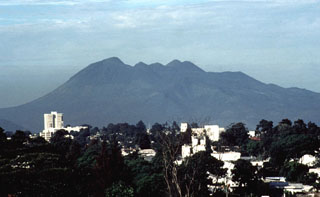Report on Pacaya (Guatemala) — November 1990
Bulletin of the Global Volcanism Network, vol. 15, no. 11 (November 1990)
Managing Editor: Lindsay McClelland.
Pacaya (Guatemala) Increased Strombolian activity and seismicity; aa lava
Please cite this report as:
Global Volcanism Program, 1990. Report on Pacaya (Guatemala) (McClelland, L., ed.). Bulletin of the Global Volcanism Network, 15:11. Smithsonian Institution. https://doi.org/10.5479/si.GVP.BGVN199011-342110
Pacaya
Guatemala
14.382°N, 90.601°W; summit elev. 2569 m
All times are local (unless otherwise noted)
Fieldwork was conducted at the volcano by a group from the Univ de Genève (mid October-4 November), and scientists from Michigan Technological Univ and Guatemala (25 November).
The following is modified from a Univ de Genève report. Strombolian activity increased during October, to >400 recorded explosions/day. Scientists visting the volcano observed explosions every 30 seconds to 5 minutes (17 and 21 October), and counted up to 17 explosions during a 15-minute period (28 October). The explosions ejected incandescent material to 10-50 m above the 25-m-tall cone in MacKenney crater, and were visible on clear nights from Guatemala City (25 km NNE). The number of seismic events (recorded by a joint INSIVUMEH-Univ de Genève digital seismic station) increased steadily, from 147 on 13 October to 457 on 20 October, and averaged over 450 daily during the following several days. Tremor was recorded during periods of closely spaced explosions (including the 28th), with 5 hours of continuous tremor recorded on the 20th. As of 4 November, two lava flows were moving down the N flank of the volcano, and explosive activity was unchanged.
The following report is by Michael Conway. "Vertical Strombolian eruptions (lasting from seconds to <1 minute) from the crater of MacKenney cone occurred every 3-5 minutes, hurled incandescent bombs (to 2 m in diameter) to 150 m above the vent, and were accompanied by a jet-like sound. Black eruption clouds, with the coxcomb geometry characteristic of phreatomagmatic blasts, were rarely observed, suggesting that the conduit is moderately well sealed from infiltrating meteoric waters. Low-temperature fumaroles (up to 100°C) were active on the E summit of MacKenney cone, and patches (areas of one to tens of m2) of yellow sublimates were common.
"An aa lava flow was being extruded from a pit crater (50 m long, 10-15 m wide, and 2-5 m deep) on the N flank of MacKenney cone, 40-65 m below the summit; opening of the pit crater may be related to an eruptive episode that occurred on 16 September. A lava channel, 5 m wide and 2-4 m deep, delivered lava to the low-lying area between MacKenney cone and Cerro Chino. The lava flux was variable and flow velocities ranged, roughly, from 1 to 6 km/hour. Collapse of the lava flow front was common (slopes of the cone are about 30°), exposing fresh lava and sending hot block avalanches down the channel. The latest stage of lava flow activity began on 3 November and has erupted two flow units, one of which was still active. Lava flows erupted since March have effectively armored the N-central flank of the cone. A result of continued construction of MacKenney cone is that, for the first time, the cone is visible from San Francisco de Salas (2.5 km downslope, to the N)."
Geological Summary. Eruptions from Pacaya are frequently visible from Guatemala City, the nation's capital. This complex basaltic volcano was constructed just outside the southern topographic rim of the 14 x 16 km Pleistocene Amatitlán caldera. A cluster of dacitic lava domes occupies the southern caldera floor. The post-caldera Pacaya massif includes the older Pacaya Viejo and Cerro Grande stratovolcanoes and the currently active Mackenney stratovolcano. Collapse of Pacaya Viejo between 600 and 1,500 years ago produced a debris-avalanche deposit that extends 25 km onto the Pacific coastal plain and left an arcuate scarp inside which the modern Pacaya volcano (Mackenney cone) grew. The NW-flank Cerro Chino crater was last active in the 19th century. During the past several decades, activity has consisted of frequent Strombolian eruptions with intermittent lava flow extrusion that has partially filled in the caldera moat and covered the flanks of Mackenney cone, punctuated by occasional larger explosive eruptions that partially destroy the summit.
Information Contacts: Jean-Jacques Wagner, Thierry Basset, and Jean-Charles Gentile, Univ de Genève, Switzerland; Michael Conway, Michigan Technological Univ; Ricardo Mata, Guatemala City, Guatemala; E. Sánchez and Otoniel Matías, INSIVUMEH.

